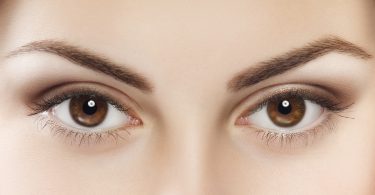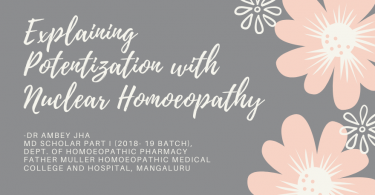
Abstract:
Background: Lifestyle disorders are defined as diseases linked with the way people live their life. This is commonly caused by lack of physical activity and unhealthy eating as well as alcohol, drug and smoking abuse. Undue tension, mental stress / anxiety, late night or inadequate sleep also play a big role in this.
Homoeopathy is an important modality which can help in curing lifestyle disorders and play a significant role in delaying the occurrence of lifestyle diseases and also in management of the same. Homoeopathy treats patients through a holistic approach and considers individualistic characteristic of one person along with the disease symptoms. Homoeopathic medicines are prescribed on the basis of symptom similarity of THE DRUG and THE PATIENT. This needs an extensive interaction between the Doctor and the Patient which we call CASE TAKING. If a correct homoeopathic medicine is selected considering physical and mental makeup of the person, it significantly delays the lifestyle disorders.
Aims and objectives: To see the applied aspect of homoeopathy in lifestyle disorder.
Material and methods: The project work was done following the books and websites.
Result: This study revealed the applied aspect of lifestyle disorder by literature review.
Conclusion: The applied aspect of homoeopathy in cases of lifestyle has a vast area of study. Specific work related to particular age groups and specific medicine needs to be carried out. The lifestyle disorder has many possibilities in field of homoeopathy.
Key words: lifestyle disorder, homoeopathy, stress, obesity.
Abbreviations: WHO – World Health Organization, LDL – low density lipoprotein, WBC’s – white blood cells
INTRODUCTION: Over the past few decades, lifestyle disorders have been on a mercurial rise. Sedentary lifestyle, amalgamated with unhealthy eating habits has been the wrecker in chief. Lack of proper awareness has made the situation even worse. The mad and competitive rush to reach the pinnacle has serious health implications. Almost every second individual suffer from some kind of lifestyle disorders. Unhealthy and stressful lifestyle has resulted in increased incidences of obesity and diabetes (Type II). Lifestyle disorders usually are chronic in nature that may last for a lifetime if appropriate measures are not taken on time. Homoeopathy is an effective and natural way of treating such disorders. Homoeopathy works in healing the whole body as a whole; it treats all the factors that trigger a cause for such disorders. Homoeopathy strengthens the immune mechanism of the individual, maintains the hormone levels and restores the harmonious functioning of all the systems together making the individual less vulnerable to such diseases. 1
AIMS and OBJECTIVES
- To see the applied aspect of homoeopathy in lifestyle disorder.
REVIEW OF LITERATURE
WHO defines lifestyle disorders as the aggregation of personal decisions (i.e., over which the individual has control) that can be said to contribute to, or cause, illness or death. A disease associated with the way a person or group of people live.
Lifestyle means a pattern of individual practices and personal behavioural choices or in a simpler way we can describe lifestyle as “the way people live”, i.e., day to day habits of an individual.2
Lifestyle diseases or disorders
The diseases which primarily arises from the abnormal lifestyle of a person are grouped under the term lifestyle diseases or disorders. Adopting an unhealthy lifestyle pattern leads to increase in both physical and mental diseases. Lifestyle diseases too have become an epidemic and causes much greater public threat than any other epidemic.
It is seen that almost every 2nd individual suffers from some kind of lifestyle diseases. Unfortunately, these lifestyle diseases are no longer restricted to people in their forties and fifties but has affecting the young adult zone and children as well. 3
Incidence and causes of lifestyle disorders
It is in practice that more than 30% of Indians over 30 years of age or even below 30 are suffering from one or more lifestyle diseases. In our day-to-day life it is seen that, there are always deadlines, office or work pressure, family pressure, due date and many other priorities. Thus, due to this continuous busy schedule and tension our mind and body are exhausted and we do not usually get the required rest. The risk of developing lifestyle disorder depends on various factors including the kind of work one does, the environment where the person lives, the type of food he consumes and various unavoidable stressful situations.
The World health organisation identifies following as major risk factors for developing lifestyle disorders.3
- Improper diet
- Stress
- Lack of physical activity
- Disturbed biological clock
- Alcoholism
- Smoking
IMPACT OF TECHNOLOGY ON HEALTH
Present or current scenario of technological advancements, globalisation, consumerism, substance abuse, disturbed family life, stress, competitive working pattern have a severe impact on the health of an individual.
When we consider each of the lifestyle diseases in our daily practise, one can see a huge number of populations are restricted to their gadgets (cell phones, laptops, computers) and hence are always in their comfort zone. They are usually unaware about how harmful the use of technology is and how it is having a negative impact on their daily life. They are only aware of its adverse effects when their body starts showing the symptoms.4
Let us see how some of the factors which are affecting health.
Prolonged use of laptops, cell phones, computers, continuous watching of television, may lead to spondylosis causing neck pain along with pain in the spine, trapezitis, tendinitis, trigger thumb, carpel tunnel syndrome, sciatica, strain on eyes, along with headache, fatigue, exhaustion, etc.
Prolong standing or wrong sitting posture gives strain on the backbone and causes chronic back pain. Also, sitting for long induces continuous pressure on posterior aspect of thighs and hips which are largest muscle group of our body and almost centrally located this obliterates blood vessel on a very significant region of body thus disturbing the blood flow and circulatory pressure and pattern giving rise to engorged vessels in ano-rectal region and coccygodynia due to pressure on tissue and lack of circulation causing damage around coccyx. Not only this the circulatory disturbance of this scale due to pressure on significantly large part of body for prolonged period of time also gives rise to low tissue perfusion of blood in the dependent part that are compressed due to pressure in sitting posture, so then there is compensatory increase blood pressure to make sufficient tissue perfusion of blood where ever the blood vessels are compressed due to seated posture and mechanical pressure compression, this leads to high blood pressure.5
Radiations generated by cell phones, and heat generated by laptop have adverse effect on the fertility. People working against the biological clock, working continuously on computers causing insomnia, and gastric disturbances. Not to mention the addiction and psychological stress produced sue to social sites and unhealth mind again leads to unhealthy body.5
SOME COMMON TYPES OF LIFESTYLE DISORDERS
It is usually seen that the onset of lifestyle disorders is insidious, it may take years to develop one. But once these disorders are detected there has to be a total vigilance in the way of life along with proper medication and treatment for the same. In present generation Stress tops the chart of causation of many diseases like obesity, diabetes, hypertension, cancers, etc.
Not that stress was never present in our ancestors in the past, but it was combated with stress busters like spending time with family and friends, exercising, meditation, etc., in present generation mankind had distanced self from all this stress busters and are more influenced by technology.6,7
Common lifestyle disorders
INSULIN RESISTANCE and METABOLIC SYNDROME
Imbalance in energy utilisation and storage, as a result of disturbances in multiple physiological functioning, especially insulin resistance considered as a major contributing factor which results into metabolic syndrome which presents itself with collection of signs like hyperglycaemia, central obesity hypertension, dyslipidaemia – high triglycerides and low HDL.
Lifestyle factors like Stress, disturbed chronobiology, improper diet, frequent consumption of sugar sweetened beverages, alcoholism substance abuse or psychotropic and certain other long-term medications, sedentary life, and definitely genetics play a major role in development of metabolic syndrome.6,7
OBESITY
India has been ranked as second highest nation to have huge number of obese
individuals. Obesity is a very fatal condition which makes an individual more
vulnerable to lifestyle disorders. Obesity is one of the important disorders
caused due to sedentary lifestyle, unhealthy eating habits, reduced
physical activity, stressful life, etc.6,7
DIABETES MELLITUS
Diabetes mellitus is a metabolic disorder. It is a complex condition in which the blood sugar levels are raised for a long period of time either because of inadequacy of insulin production or lack of body cell responses to insulin. Diabetes is also a result of age, stress, sedentary lifestyle, obesity, etc.6,7
HYPERTENSION
Hypertension is a term used for a condition of body in which the blood pressure is higher than the normal. It’s one of the common lifestyle disorders. Various causes related to hypertension mainly stress, sedentary lifestyle, increased salt intake.
Basically, hypertension in most of the cases is a compensatory mechanism of the body which is brought in place by body to counter reduced tissue perfusion of blood caused due to obesity lack of exercise and wrong postures where circulation is obliterated of a larger area due to pressure for long period like sitting in almost same posture for long or lying in almost same posture for long; Or in posture where dependent parts are not moved for a longer period of time causing difficulty in circulation due gravity like standing for prolonged period or hanging limbs for prolonged period of time.
Salt restriction, regular exercise, proper diet, decrease stress help to manage hypertension. 6,7
CARDIOVASCULAR DISEASES
Any abnormality or
irregularity which affects the heart muscles and blood vessel walls can be referred
to as heart disease. Elevated level of cholesterol and triglycerides are major
markers for heart diseases.
There is a huge number of populations in India who suffer from cardiovascular
diseases. Again, it is one of the lifestyle disorder sedentary habits, stress,
increased level of cholesterol, improper diet is some of the reasons for
cardiovascular diseases. 6,7
CARCINOMAS
Due to stressful lifestyle, we lead, there is decrease in immunity of our body, WBC’s lose their power to fight the viruses that enter our body. There may be an irregular cell growth which can be concluded as carcinoma when diagnosed appropriately. 6,7
RESPIRATORY DISEASES
In present practice we notice a huge number of populations suffering from recurrent respiratory tract infections. It may be worsened due to continuous influence to body to obnoxious agents, may be occupational harmful chemical exposures, prolong use of antihistamines anticold cough medicines, habit of smoking has a very severe impact on health which leads to various respiratory diseases. 6,7
AUTOIMMUNE COMPLAINTS
Due to sedentary lifestyle, decreased physical activity, obesity and improper diet many other causes lead to various joint complaints like arthritis, rheumatoid arthritis, gout etc. 6,7
DEPRESSION AND ANXIETY
Stress and anxiety trigger a number of lifestyle disorders. Continuous worry stress, family tensions, work pressure, health concerns, unemployment, love failures have a direct impact on the mental or emotional health of the person. Continuous stress worry leads to anxiety neurosis and depression.
Along with the above-mentioned lifestyle disorders there are various other diseases which directly or indirectly have an impact on the health of an individual due to lifestyle. 6,7
ROLE OF HOMOEOPATHY IN LIFESTYLE DISEASES OR DISORDERS.
Homoeopathy plays a very significant role in the management of lifestyle disorders. Lifestyle disorders are a threat to the socio-economic aspect of nation globally and appropriate actions for their management are the need for the moment. Management of lifestyle diseases include proper diagnosis and treatment for the same.8,9,10,11,12
Homoeopathic view of disease and health:
Disease = Dis + ease
Disease is Mother Nature’s response to our indulgence and our unmitigated efforts to self-destruct through over-indulgence. Disease is nature’s way of slowing us down.
Health is a joyous journey back to harmony of Body +Mind + Spirit.
Homoeopathy has a major role to play in the management of present-day lifestyle diseases. Homoeopathy medicines strengthens the immunity of the body to fight against pathogens. They act on much deeper level both at physical and emotional health. Homoeopathy is a complete system of medicine discovered by a German physician, Dr Samuel Hahnemann. 8,9,10,11,12
Dr Hahnemann highlights the importance of healthy lifestyle. He has advised to remove all influences which hinder cure. According to him hinderances to the cure of chronic diseases are excessive hardships, labouring, grief, hunger, poverty, sudden death of loved ones, etc. He advised to avoid sedentary life that interferes with health. 8,9,10,11,12
In case of lifestyle disorders Homoeopathic management include a detailed individualised study of the patient. A constitutional medicine is selected based on individualised approach. A holistic approach towards each case really helps to give wonderful results. 8,9,10,11,12
Some rubrics related to lifestyle disorder in different repertories
Rubrics related to sedentary lifestyle in different repertory:13
- In Boericke repertory
MODALITIES –
Aggravation – Sedentary habits: (9) acon. aloe am-c. anac. arg-n. bry. con. Nux-v.
sep.
ABDOMEN – Anus, rectum – Prolapsus ani – with – piles, in alcoholics, leading
sedentary life: (1) aesc-g.
NERVOUS SYSTEM – Nervous affections – From – tobacco, in sedentary persons;
dyspepsia, right prosopalgia: (1) sep.
ABDOMEN – Haemorrhoids – Aggravations – from – alcoholic abuse, in sedentary
persons: (2) aesc-g. nux-v.
STOMACH – Indigestion dyspepsia – Cause – Sedentary life: (1) nux-v.
- In Boenninghausen’s repertory
HEAD – Internal –
aggravation – sedentary living: (2) Acon. NUX-V.
STOOL – Aggravation and amelioration – sedentary living agg.: (6) BRY.
lyc. NUX-V. op. Plat. SULPH.
CONDITIONS OF AGGRAVATION AND AMELIORATION IN GENERAL – Sedentary occupations: (1)
NUX-V.
STOMACH – Digestion – weak – sedentary living: (5) bry. calc. NUX-V. sep.
Sulph.
- Clarke J. Clinical repertory
Temperaments –
sedentary:
Temperaments – sedentary – women: (1) am-c.
Temperaments – sedentary – habits, persons of: (13) acon. alum. anac. calc. cocc.
con. nat-m. nux-v. petr. sep. sil. sulph. ter.
Temperaments – women – sedentary: (1) am-c.
Temperaments – sedentary – literary men, sick and chilly: (1) asar.
Temperaments – habits, sedentary: (15) acon. alum. am-c. anac. asar. calc. cocc.
con. nat-m. nux-v. petr. sep. sil. sulph. ter.
Temperaments – men – literary, sedentary, who are sick and chilly: (1) asar.
Temperaments – literary men – sedentary, sick and chilly: (1) asar.
Temperaments – chronic – ailments of – sedentary persons: (1) alum.
Causation – sedentary habits: (1) aloe
Temperaments – sedentary – persons, chronic ailments of: (1) alum.
Temperaments – life – sedentary, persons who lead a: (1) nux-v.
- Kent repertory:
RECTUM – CONSTIPATION
– sedentary habits,from : (10) aloe Ambr. Bry. Lyc. NUX-V.
Op. PLAT. Podo. Sep. Sulph.
MIND – ANXIETY – sedentary employment,from: (2) Ars. graph.
- Phatak’s repertory
S – Sedentary living
– agg: (4) aloe asar. NUX-V. Sulph.
S – Sedentary living:
M – Menses – copious, profuse, excessive – women young, in – sedentary habits,
of: (1) coloc.
S – Sedentary living – burning, spots, from: (1) ran-b.
- Synthesis repertory
STOMACH – SLOW
DIGESTION – sedentary living: (5) bry. calc. Nux-v. sep. sulph.
STOMACH – INDIGESTION – sedentary life; from: (1) nux-v.
GENERALS – PAIN – Spots; in – sedentary living; from: (1) ran-b.
GENERALS – WEAKNESS – sedentary habits agg. – women; in: (1) helon.
RECTUM – HEMORRHOIDS – sedentary persons; in: (2) aesc-g. nux-v.
RECTUM – CONSTIPATION – sedentary habits agg.: (14) aloe alum. Ambr. Bry.
hydr. Lyc. nat-m. NUX-V. Op. PLAT. Podo. Sep.
Sulph. thuj.
GENERALS – SEDENTARY HABITS: (29) acon. aloe alum. am-c. anac. arg-n. ars. asar.
bell. Bry. Calc. Caps. cocc. colch. coloc. con. guar. hydrog.
Lyc. nat-m. NUX-V. petr. Puls. rhus-t. sep. sil. staph. sulph.
ter.
GENERALS – SEDENTARY HABITS – women; in – obese: (1) am-c.
SLEEP – SLEEPINESS – sedentary habits, in persons of: (1) Gels.
GENERALS – SEDENTARY HABITS – women; in: (2) am-c. coloc.
STOOL – SEDENTARY HABITS AGG.: (6) BRY. lyc. NUX-V. op. plat. Sulph.
GENERALS – PAIN – Spots; in – sedentary living; from – burning: (1) ran-b.
HEAD – SEDENTARY HABITS AGG.: (2) acon. Nux-v.
HEAD – PAIN – chronic – sedentary habits; from: (4) anac. Arg-n. bry. Nux-v.
GENERALS – NEUROLOGICAL COMPLAINTS – tobacco; from – sedentary habits; in
persons with: (1) sep.
RECTUM – PROLAPSUS – drunkards leading sedentary life; in: (1) aesc-g.
GENERALS – WEAKNESS – sedentary habits agg.: (3) helon. nux-v. sulph.
PREVENTION OF LIFESTYLE DISORDER
A healthy lifestyle should be adopted to combat life style disorders.14
Health rests on three pillars
- DIET
- EXERCISE
- REST
If any one of above three is disturbed the health will fall14
PROPER DIET
There is a well-known proverb in ayurveda that says” If your diet is not proper, no medicines will work And if diet is proper, then no medicines will be required.”
Diet
rich in fibre and nutrients, fresh fruits, vegetables should be a regular part
of meal.
Avoid skipping meals., junk food, fatty food, aerated drinks as they do no good
but just harm the body in many ways. 14
ADEQUATE EXERCISE
Exercise helps improve circulation and secrete ample of anabolic hormones thus wash off metabolites and other harmful substances from body.
The root cause of most of the lifestyle disorders is obesity. It is really important to maintain a ideal body weight. Regular exercise, brisk walk, yoga helps to combat many diseases14
REST TO MIND AND BODY
Stress management
Proper hormone flow depends much on balanced mind as its optimal balance is dependent on a very delicate Hypothalamic-Pituitary-Hormonal Axis. Which is much dependent on psychological wellbeing and vice-a-versa.
Proper guidance and counselling to combat stress. Involve in recreational activities which help to relieve stress. Practice yoga, music therapy, maintain a balance between work and family., proper balanced food with adequate sleep. 14
Adequate sleep
Most of the hormones and other repair mediators within body are secreted most abundantly during and deeper the sleep better the repair work in body. Continuous and undisturbed sleep of 7 to 8 hours helps to solve many health issues. 14
MATERIALS and METHODS
The project work was done following the books and websites
OBSERVATIONS
After following the study, it became quite apparent that the subject chosen is an area for research. The lifestyle disorder has many possibilities in field of homoeopathy. The possibilities need to be worked out and the probabilities of the simillimum within the knowledge of organon of medicine and psychology and beyond the existing knowledge needs careful evaluation.
DISCUSSION
The applied aspect of homoeopathy in cases of lifestyle has a vast area of study. Specific work related to particular age groups and specific medicine needs to be carried out. The lifestyle disorder has many possibilities in field of homoeopathy.
SUMMARY
The lifestyle disorder in homoeopathy is a subject which more needs clinical orientation from the homoeopathic view point. Moreover, the works done in this aspect, have been more oriented to a particular age group. More works need to be done in regards to patients of particular economic strata, habitat aspect and nature of their daily routine, including the profession which they belong. The occupation has at times its own hazard and needs to be properly evaluated in order to find the effect of medicine in such individual.
REFERENCES
- Sharma M, Majumdar PK (2009). Occupational lifestyle diseases: An emerging issue. Indian Journal of Occupational and Environmental Medicine, 13(3), 109–112.
- Beaglehole R, Bonita R. (2008). Global public health: A scorecard. Lancet, 372(9654):1988–1996
- Atomictherapy.org. [cited 2022 Sep 05]. Available from: https://atomictherapy.org/lifestyle-diseases/Tubbish SA, Lifestyle diseases: consequences, characteristics, causes and control: 2017: available on medcraveonline.com
- Kumar R, Kumar M:Guide to Prevention of Lifestyle Diseases:2004
- Holt McDougal Lifetime Health Chapter 14 Resource File: Lifestyle Diseases; 2004
- Park k. Park’s textbook of preventive and social medicine. 25th ed. Jabalpur: M/s Banarsidasbhanot publishers; 2020.
- Munjal Y. API textbook of medicine. 10th ed. New Delhi: Jaypee Brothers medical publisher; 2015.
- Hahnemann S: Organon of Homoeopathic Medicine: 6th edition:1922: aphorisms2,7,26-30,31,77,83,150,210-230
- Roberts HA: The Principles and Art of Cure by Homoeopathy:3rd edition:119-121 pg
- Kent JT. Repertory of homoeopathic materia medica. New delhi: Bjain publishers; 2014.
- Boericke W, Boericke O. Boericke’s new manual of homoeopathic materiamedica with repertory. 9th ed. New delhi: Bjain publishers; 2016.
- Schroyens F. Augmented clinical synthesis. 9.1 ed. New delhi: Bjain publishers; 2008.
- Researchgate.net.
. Available from: https://www.researchgate.net/publication/344655092_Personalized_Care_Prevention_of_Lifestyle_Diseases
About the Author:
Dr Nihal Kumar M.D. (HOM)





